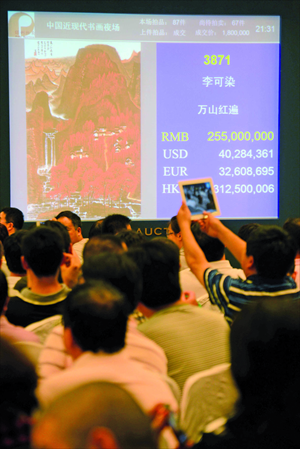Spring bust

Qi Baishi (1864-1957), one of China's most influential painters noted for his watercolor paintings, once had his art auctioned for almost half a billion yuan. But sales at this year's spring auction were pale in comparison.
In 2011, his ink-wash painting, Eagle Standing on Pine Tree with Four - character Couplet in Seal Script, sold for a record-breaking 425.5 million yuan ($65 million).
The record-breaking price for Qi's ink-wash paining was also his largest work, measuring 266 centimeters by 100 centimeters. The painting was accompanied by a pair of calligraphy scrolls, each measuring 264.5 centimeters by 65.8 centimeters.
However, the highest price for his work this year came out to 21.28 million yuan ($3.08 million), for a landscape painting of bamboos and mountains.
Based on figures provided by China Guardian Auction, Poly International Auction and Beijing Council International Auction, 316 pieces of Qi's paintings were put on bid at the spring auction last year; 28 of them had no bidders. At last year's autumn auction, 85 out of 284 Qi painting failed to sell.
This year, 173 pieces of Qi's paintings appeared at the spring auction, and 39 of the works failed to sell.
"The situation is not as bad as people think. Last fall was the worst time for the market. It is getting better this year," said an industry insider.
Hua Niao (flower and bird) was auctioned at the price of 92 million yuan in 2011. Prices like this were then the norm for Qi's notable pieces.
"Most of Qi's works sold in the spring are not his best or most renowned pieces," said the insider.
"The relatively low auctioned price this year doesn't mean that Qi is not popular anymore, said Xie Xiaodong, vice general manager of Beijing Council.
He added that Qi's works have always been an important part of contemporary Chinese painting and that the reduced numbers in the spring auction does not reflect the art market at large.
Beijing Council held a special fair for Qi, putting 51 items on bid, with satisfactory results: Over 88 percent were successfully auctioned, raking in a total of 83.47 million yuan.
Qi's most common watercolor works are of shrimp, birds, insects and flowers, painted in his signature playful style.
"Paintings of landscapes are rare," said Xie. "That is why the price is higher than the other paintings."
"A piece that is not sold does not [reflect] the overall market," said William Chak, a Hong Kong collector. "The percentage of successful auctions in Hong Kong is higher than in Beijing. The high number of unsold items in Beijing is [perhaps attributed] to many of the same pieces being up for sale in recent years. Everyone wants to bid for 'new' things."
In the same category, contemporary and modern Chinese artist Li Keran's (1907-89) Landscape in Red started bidding at 180 million yuan and was sold for 293 million at Poly's spring auction, a personal record for Li.
"This piece was painted at the peak of Li's career. The price was rational," said Zhao Xu, executive director of Poly.
"Buyers are more rational now," said Chak. "But good items will always be sold at a reasonable price."
The recent surge in price for items such as snuff bottles and porcelain tiles is seen by many art industry insiders as a shift in tastes and focus.
"People abroad started collecting snuff bottles a while ago," said Chak. "The entire art market in China is in development. Interests in collection are spontaneous."
Guangzhou Daily-Global Times